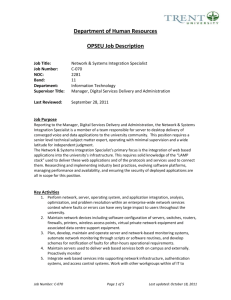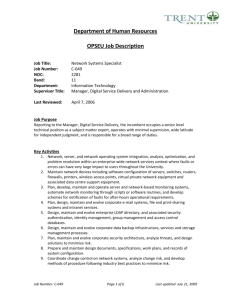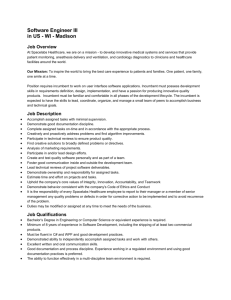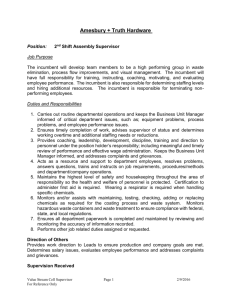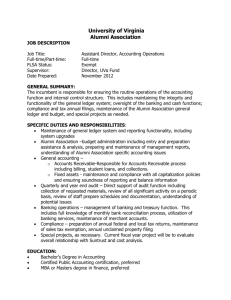doc.: IEEE 802.22
advertisement
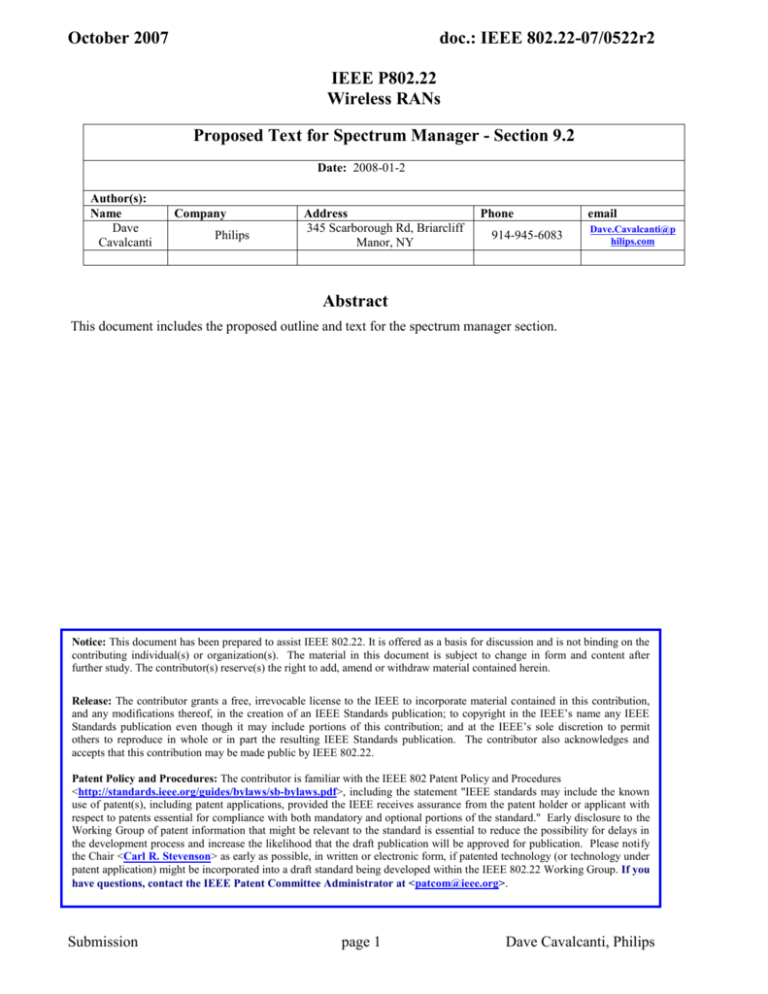
October 2007
doc.: IEEE 802.22-07/0522r2
IEEE P802.22
Wireless RANs
Proposed Text for Spectrum Manager - Section 9.2
Date: 2008-01-2
Author(s):
Name
Dave
Cavalcanti
Company
Philips
Address
345 Scarborough Rd, Briarcliff
Manor, NY
Phone
914-945-6083
email
Dave.Cavalcanti@p
hilips.com
Abstract
This document includes the proposed outline and text for the spectrum manager section.
Notice: This document has been prepared to assist IEEE 802.22. It is offered as a basis for discussion and is not binding on the
contributing individual(s) or organization(s). The material in this document is subject to change in form and content after
further study. The contributor(s) reserve(s) the right to add, amend or withdraw material contained herein.
Release: The contributor grants a free, irrevocable license to the IEEE to incorporate material contained in this contribution,
and any modifications thereof, in the creation of an IEEE Standards publication; to copyright in the IEEE’s name any IEEE
Standards publication even though it may include portions of this contribution; and at the IEEE’s sole discretion to permit
others to reproduce in whole or in part the resulting IEEE Standards publication. The contributor also acknowledges and
accepts that this contribution may be made public by IEEE 802.22.
Patent Policy and Procedures: The contributor is familiar with the IEEE 802 Patent Policy and Procedures
<http://standards.ieee.org/guides/bylaws/sb-bylaws.pdf>, including the statement "IEEE standards may include the known
use of patent(s), including patent applications, provided the IEEE receives assurance from the patent holder or applicant with
respect to patents essential for compliance with both mandatory and optional portions of the standard." Early disclosure to the
Working Group of patent information that might be relevant to the standard is essential to reduce the possibility for delays in
the development process and increase the likelihood that the draft publication will be approved for publication. Please notify
the Chair <Carl R. Stevenson> as early as possible, in written or electronic form, if patented technology (or technology under
patent application) might be incorporated into a draft standard being developed within the IEEE 802.22 Working Group. If you
have questions, contact the IEEE Patent Committee Administrator at <patcom@ieee.org>.
Submission
page 1
Dave Cavalcanti, Philips
October 2007
doc.: IEEE 802.22-07/0522r2
9.2 Spectrum Manager
The Spectrum Manager, as shown in the 802.22 reference model (Figure 6), is part of the management plane. Although the
reference model in Figure 6 applies to both BS and CPEs, the spectrum manager at the WRAN BS is responsible for the most
important tasks, such as maintaining spectrum availability information, channel selection, channel management and selfcoexistence. On the other hand, the spectrum manager entity at the CPE is a much simpler entity including only essential
features to allow proper CPE operation when it is not under the control of a BS, such as during initialization (before
association with the BS), and basic functionalities to respond/react to the BS’s requests and commands. Throughout this
document, we use the term Spectrum Manager (SM) to refer to the spectrum manager entity at the WRAN BS, whereas the
corresponding entity at the CPE is called CPE Spectrum Automaton (SA). The following clauses describe the SM
functionalities. The CPE SA entity is described in Section XXX.
The SM is a central entity part of the WRAN BS, which is responsible for ensuring protection of incumbents and efficient
spectrum utilization while complying with regulatory policies. For that, the SM centralizes all the decisions within the
WRAN cell with respect to spectrum availability and utilization. In summary, the key functions of the SM are the following:
Maintain Spectrum Availability Information;
Channel Classification and Selection;
Association control;
Channel Management;
Self-coexistence with other WRANs.
These functions are described in the following clauses. It is important to note that this standard do not specify the any
particular SM implementation, but instead, it describes the mandatory behavior for any SM implementation in order to ensure
proper protection of incumbents, compliance with regulatory policies, and interoperability amongst different WRAN
implementations.
9.2.1
Maintain Spectrum Availability Information
The SM shall maintain the status of the spectrum (i.e. TV channels) available for the WRAN operation at its location within a
regulatory domain according to the policies and rules established for that domain (e.g. regulatory rules established by the
FCC in the US for use of TV channels). The SM shall define the channel status with respect to the presence of incumbents
and other WRANs in the area, and it shall use this information as input for its decisions with respect to channel selection,
channel management and self-coexistence mechanisms.
To maintain the status of the channels available for operation, the SM shall be able to aggregate information from at least the
following sources:
1. Incumbent database: The SM shall be able to access incumbent databases through the higher layers if such
incumbent databases exist within WRAN’s regulatory domain.
2. Geolocation: the SM shall be able to access geolocation information available at the BS to identify its own
location, and it shall also be obtain location information from all CPEs associated or that are requesting
association with the BS.
3. Spectrum sensing: the SM shall use the MAC and PHY layer functionalities and management frames to
control and coordinate spectrum sensing within the WRAN cell. The SM shall trigger the requests for CPEs to
perform sensing and collect sensing reports from CPEs. The SM shall control spectrum sensing performed
locally by the BS and it shall combine the local results with the results collected from CPEs.
Wherever it is required by regulatory rules, the SM shall define the status of the channels with the respect to the presence of
incumbents by combining geolocation information, information available in incumbent databases, spectrum sensing results
and predefined regulatory rules. If an incumbent database is not available in a specific regulatory domain, the SM shall define
the availability of the channels based on spectrum sensing information. Other methods to determine the channel availability
may be used depending on the policies for each regulatory domain.
The channel availability information shall be defined during the network initialization and it shall be maintained current
during the network operation as required by regulation.
Submission
page 2
Dave Cavalcanti, Philips
October 2007
doc.: IEEE 802.22-07/0522r2
The spectrum sensing information used to determine the channel availability status shall be updated every 2 sec for the
operating channel and every 6 sec for backup channels. In addition, before the SM declares a given channel available for
operation based on spectrum sensing, it shall ensure that the channel has been sensed at least every 6 sec within the last 30
sec.
9.2.2
Channel Classification and Selection
The SM is responsible for selecting the operating channel and assigning it to the MAC/PHY modules in the WRAN. The SM
is also responsible for defining the backup channel(s) and their corresponding priorities. The rest of the channels that are
potentially available for operation, but that are not selected as the operating channel or as backup channel(s), may be
classified as a candidate, occupied or disallowed channel(s). The channels may be classified using the following categories:
Available: channels available for potential WRAN operation at a given location according the incumbent databases,
if such databases exist. If incumbent databases exist, the channels not deemed available by the databases are precluded
for use by WRANs. If no incumbent database exists, the available channels shall be determined by spectrum sensing.
Disallowed: channels that are forced unavailable for use by the WRAN by the operator.
Operating: the current channel used for communication between BS and CPEs within a WRAN cell. In order to
ensure protection of incumbents, the operating channel must be sensed at least every 2 seconds.
Backup: channels that can become the operating channel right away in case the WRAN needs to switch to another
channel. The BS may maintain multiple backup channels at any given time, which shall be ordered according to their
relative priorities. Backup channels shall be sensed for incumbent detection at least once every 6 seconds.
Candidate: channels that are candidates to become a backup channel. These are channels that the BS may request
the CPEs to sense to evaluate the possibility of elevating these channels to a backup channel status. Although sensing
of candidate channels could be infrequent, before a candidate channel is elevated to backup channel, it must be sensed
as incumbent-free at least every 6 seconds for no less than 30 seconds.
Occupied: channels in which incumbent or WRAN operation has been detected through sensing. Occupied channels
may become available for operation in case the incumbent leaves the channel. Sensing is needed to determine whether
the incumbent is still present on the channel, but sensing could be infrequent in these channels. An occupied channel
may also become a backoff channel, but before an occupied channel is elevated to backup channel, it must be sensed as
incumbent-free at least every 6 seconds for no less than 30 seconds. The SM should identify the type of signal
occupying every occupied channel (see Table 276).
Unclassified: channels that have not been sensed. These channels may be sensed according to the SM
implementation. Once an unclassified channel has been sensed, it may be re-classified as occupied or candidate
channel depending on the sensing results.
The specific algorithms for selecting the operating channel and defining the priorities amongst channels available for backup
or candidate is outside the scope of this standard. However, any implementation of these algorithms shall use as input current
channel availability information (as described in Section 9.2.1) and combine the channel status information with predefined
the rules applicable to the specific regulatory domain. Furthermore, other criteria could also be taken into account by the
implementation, such as traffic requirements, location information, and coexistence with neighboring WRANs.
9.2.3
Association Control
When CPEs request association with a WRAN BS (see CPE initialization procedure described in XXX), the SM is
responsible for granting or denying association rights to the requesting CPEs. For that, the SM shall consider location
information, and capabilities of each requesting CPE. The SM shall access the incumbent databases, if existent, to obtain the
list of available channels and corresponding required max EIRP limits at the CPE’s location, and based on the received
information, the SM shall decide whether to grant association rights to the CPE in its current operating channel. It is the
responsibility of the SM to ensure that by granting association rights to the requesting CPE, it will not cause harmful
interference to incumbents.
9.2.4
Submission
Channel Management
page 3
Dave Cavalcanti, Philips
October 2007
doc.: IEEE 802.22-07/0522r2
The SM is responsible for triggering channel management actions within the cell in order to guarantee the required protection
of incumbents while supporting QoS for the WRAN users. The channel management actions include:
1. Switch the entire cell to a new operating channel;
2. Direct a single CPE or a group of CPEs to a different operating channel;
3. Terminate operation in a given channel for a single CPE, a group of CPEs or the entire cell;
4. Inform CPEs of channels status updates (e.g. changes in backup channels, channel status information);
The SM shall use one of the channel management mechanisms defined in the 802.22 MAC layer (see 6.20.4) to execute the
appropriate action.
Each channel management action may be triggered by one or more events. For instance, the action of switching channels for
the entire cell may be triggered by the detection of an incumbent on the operating channel, by degradation of the QoS due to
interference, or traffic load in the current channel. Although different trigger events may be supported depending on the
implementation, the trigger events and corresponding channel management actions shall ensure protection of incumbents as
required by regulatory policies applicable within the regulatory domain. A list of possible trigger events and actions needed
to protect incumbents is given in Table 1.
Table 1 — Trigger Events and Corresponding Actions
Trigger Event
If the SM confirms the presence of a TV Incumbent signal above
the detection threshold on the operating channel through the BS
spectrum sensing function or through a combination of sensing
results from multiple CPEs.
If the SM confirms the presence of a Wireless Microphone signal
above the detection threshold or decode a legitimate TG1 beacon
on the operating channel through the BS spectrum sensing
function.
If the SM obtain information from an incumbent database that
indicates the current operating channel will become unavailable at
a specific time in the future.
If the SM confirms the presence of a Wireless Microphone signal
above the detection threshold or a legitimate TG1 beacon in the
current that was reported by a CPE.
If a TV incumbent is confirmed on the operating channel by the
BS spectrum sensing function and there is no backup channel
available.
9.2.5
Action
Switch the entire cell to a new operating
channel within the next 2 seconds, which
should be the highest priority backup
channel.
Switch the entire cell to a new operating
channel within the next 2 seconds, which
should be the highest priority backup
channel.
Schedule a channel switch for the entire
cell to a new operating channel before the
expected time (as obtained from the
incumbent database) at which its current
channel will become unavailable.
Direct the CPE to a different operating
channel or terminate the operation of the
CPE in its current channel within 2
seconds.
Terminate the operation of the entire cell
in the current operating channel within 2
seconds. Note that this action will interrupt
all the services to users, and therefore it
should only be executed if no other
channel becomes available for operation
before the action is executed.
Self-Coexistence with other WRANs
The SM is responsible for managing the channel selection for self-coexistence with other WRANs by using the selfcoexistence mechanisms defined in the 802.22 MAC (6.20.2).
Submission
page 4
Dave Cavalcanti, Philips
October 2007
doc.: IEEE 802.22-07/0522r2
9.3 Incumbent Database Services
The SME provides access to external incumbent databases services to the SM accessed through the SME-MLME-SAP. The
SME-MLME-SAP is an interface that provides a means of exchange information between the SM and the SME. Table 2
summarizes the primitives supported by the MLME to access incumbent database services through the SME-MLME-SAP
interface. The primitives are discussed in the subclauses referenced in the table.
Table 2—Incumbent Database Primitives supported by the SME-MLME-SAP
Name
Request
SME-MLME-AVAILABLE-DB
SME-MLME-QUERY-DB
SME-MLME-DB-RESPONSE
Indication
9.3.1
9.3.3
Confirm
9.3.2
9.3.4
9.3.5
9.3.1 SME-MLME-AVAILABLE-DB.request
The SME-MLME-AVAILABLE.request primitive allows the SM to identify what incumbent database services are accessible
through the SME in order to obtain channel availability information. The SME-MLME-AVAILABLE.request primitive has
no attributes.
9.3.1.1 When generated
The SME-MLME-AVAILABLE.request primitive is generated by the SM of a BS and issued to its SME to identify the types
of incumbent database services that can be accessed through the SME.
9.3.1.2 Effect on receipt
When the SME of a BS receives the SME-MLME-AVAILABLE.request primitive, it generates a SME-MLMEAVAILABLE.confirm primitive to indicate the types of incumbent database services available.
9.3.2 SME-MLME-AVAILABLE-DB.confirm
The SME-MLME-AVAILABLE.confirm primitive allows the SME to inform the SM of the types of incumbent database
services that are accessible through the SME. Table 4 specifies the parameters for the SME-MLME-AVAILABE-DB.confirm
primitive.
Table 3—SME-MLME-AVAILABLE-DB.confirm parameters
Name
Type
Valid Range
TV Incumbent Database
0-1
Part 74 Incumbent Database
0-1
Description
The value indicates whether a TV
Incumbent Database is available.
0 = database is not available
1= database is available
The value indicates whether a Part 74
Incumbent Database is available.
0 = database is not available
1= database is available
9.3.2.1 When generated
The SME-MLME-AVAILABLE.confirm primitive is generated by the SME and issued to its MLME when a SME-MLMEAVAILABE-DB.request primitive is received to indicate the types of incumbent database services that can be accessed
through the SME.
Submission
page 5
Dave Cavalcanti, Philips
October 2007
doc.: IEEE 802.22-07/0522r2
9.3.2.2 Effect on receipt
When the SM of a BS receives the SME-MLME-AVAILABLE.confirm primitive, it identifies the types of incumbent
database services available.
9.3.3 SME-MLME-QUERY-DB.request
The SME-MLME-QUERY-DB.request primitive allows the SM to request the SME to access an incumbent database in order
to obtain channel availability information. Table 3 specifies the parameters for the SME-MLME-QUERY-BD.request
primitive.
Table 3—SME-MLME-QUERY-DB.request parameters
Name
Database_type
Type
Integer
Valid Range
0-8
Description
The value identifies the type of database
for which the query is directed.
0 = TV Incumbent Database
1 = Part 74 Incumbent Database
Latitude
Longitude
TBD
TBD
9.3.3.1 When generated
The SME-MLME-QUERY-DB.request primitive is generated by the SM of a BS and issued to its SME to request the SME
to query an external incumbent database.
9.3.3.2 Effect on receipt
When the SME of a BS receives the SME-MLME-QUERY-DB.request primitive, it generates a query to the external
database available corresponding to the type indicated in the Database_type attribute.
On receipt of a the SME-MLME-QUERY-DB.request with the Database_type corresponding to a type of database which is
not available or which is not accessible through the SME, the SME of the BS shall issue a SME-MLME-QUERYDB.confirm primitive to the MLME with status value of INVALID_REQUEST.
9.3.4 SME-MLME-QUERY-DB.confirm
The SME-MLME-QUERY-DB.confirm primitive is used to inform the SM whether its request to query an external
incumbent database service was successfully generated by the SME. Table 4 specifies the parameters for the SME-MLMEQUERY-DB.confirm primitive.
Table 4— SME-MLME-QUERY-DB.confirm parameters
Name
Database_type
Type
Integer
Valid Range
0-8
Description
The value identifies the type of
database for which the query request
was directed.
0 = TV Incumbent Database
1 = Part 74 Incumbent Database
Status
Submission
Enumeration
SUCCESS,
INVALID_REQUEST
page 6
The value indicates whether the
requested query was successfully
generated.
Dave Cavalcanti, Philips
October 2007
doc.: IEEE 802.22-07/0522r2
9.3.4.1 When generated
The SME-MLME-QUERY-DB.confirm primitive is generated by the SME and issued to the MLME to indicate whether a
recieved SME-MLME-QUERY-DB.request was valid, in which case a query to an external database was generated and sent
to the upper layers.
9.3.4.2 Effect on receipt
When the SM receives the SME-MLME-QUERY-DB.confirm it will identify whether its request to access the external
database was successfully received by the SME and a query to the database was generated. The status parameter indicates the
appropriate error code from Table XX in case the requested database is not available.
9.3.5 SME-MLME-DB-RESPONSE.indication
The SME-MLME- DB-RESPONSE.indication primitive is used to inform the SM when a response to a previously issued
query to an external incumbent database service was successfully received by the SME. Table 4 specifies the parameters for
the SME-MLME- DB-RESPONSE.indication primitive.
Table 4— SME-MLME-DB-RESPONSE.indication parameters
Name
Database_type
Type
Valid Range
Integer
Description
0-8
The value identifies the type of
database for which the query
request was directed.
0 = TV Incumbent Database
1 = Part 74 Incumbent Database
Status
Enumeration
Latitude
Longitude
For (i=1 to Number of
Channels Avaliable, i++) {
Channel_Number
Max_Transmit_EIRP
}
TBD
TBD
List of
available
channels
and max
EIRP
allowed per
channel
SUCCESS,
INVALID_REQUEST,
TRANSACTION_EXPIRED
The value indicates whether a
response to query was
successfully received.
List of Available Channel
Numbers and corresponding
maximum transmit power
allowed.
9.3.1.2.1 When generated
The SME-MLME- DB-RESPONSE.indication primitive is generated by the SME and issued to the MLME to indicate the
reception of a response to a query previously issued to an incumbent database service.
9.3.1.2.2 Effect on receipt
When the SM receives the SME-MLME- DB-RESPONSE.indication it will identify whether the response to its query to an
incumbent database was successfully received by the SME, in which case, the SM will obtain the list of available channels
and corresponding latitude and longitude. If the response is not successful the SM may decide to issue another query.
Submission
page 7
Dave Cavalcanti, Philips
October 2007
doc.: IEEE 802.22-07/0522r2
9.4 PHY Spectrum Sensing Services
The PHY layer provides local spectrum sensing services through its SSF to the Spectrum Manager accessed through the
MLME-PLME-SAP. The MLME-PLME-SAP provides a means of passing information between the SM and the PHY
sublayer, the local SSF and the local Geolocation PHY module available. Table 30 summarizes the spectrum sensing
primitives supported by the PLME through the MLME-PLME-SAP interface. The primitives are discussed in the subclauses
referenced in the table.
Table 3—Spectrum Sensing Primitives supported by the MLME-PLME-SAP
Name
Request
MLME-PLME-SAP-CHANNELSENSING
MLME-PLME-SAP-SENSING-RESULTS
Indication
9.4.1
Confirm
9.4.2
9.4.3
9.4.1 MLME-PLME-SAP-CHANNEL-SENSING.request
9.4.2 MLME-PLME-SAP-CHANNEL-SENSING.confirm
9.4.2 MLME-PLME-SAP-SENSING-RESULTS.indication
Submission
page 8
Dave Cavalcanti, Philips
October 2007
doc.: IEEE 802.22-07/0522r2
9.4 Geo-location Services
The PHY layer provides geo-location services to the Spectrum Manager accessed through the PLME(GL)-SAP. The
PLME(GL)-SAP is an interface that provides a means of passing geo-location information between the SM and the PHY
sublayer (using the PLME(GL)-SAP). Table 30 summarizes the geo-location primitives supported by the PLME through the
PLME(GL)-SAP interface. The primitives are discussed in the subclauses referenced in the table.
Table 4—Geo-location Primitives supported by the (GL)-SAP
Name
Request
Indication
Confirm
XXX-GETGEOLOCATIONINFORMATION
Submission
page 9
Dave Cavalcanti, Philips
October 2007
doc.: IEEE 802.22-07/0522r2
References:
Submission
page 10
Dave Cavalcanti, Philips

